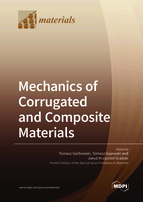Mechanics of Corrugated and Composite Materials
A special issue of Materials (ISSN 1996-1944). This special issue belongs to the section "Advanced Composites".
Deadline for manuscript submissions: closed (28 February 2022) | Viewed by 39566
Special Issue Editors
Interests: computational mechanics; structural optimization; mathematical programming; inverse problems; mechanics of materials; paper physics
Special Issues, Collections and Topics in MDPI journals
Interests: computational mechanics; inverse problem; composites; nonlinear materials; experimental techniques
Special Issues, Collections and Topics in MDPI journals
Interests: computational mechanics; corrugated cardboard; fluid mechanics; biomechanics; heat transfer; meshless methods; inverse problems
Special Issues, Collections and Topics in MDPI journals
Special Issue Information
Dear Colleagues,
This Special Issue of Materials is devoted to the mechanics of corrugated and composite materials. Corrugated materials are increasingly used as construction materials or load-bearing elements in various engineering applications. Due to the specific compositions of corrugated materials, the ratios of their load capacities to the section weights are much higher than for traditional solid sections. In addition, the geometries of the corrugated structures proposed by scientists from around the world are constantly being modified to improve their mechanical performance. Composite materials, due to their unique designable properties, may be used in many areas to address difficult problems for which traditional materials would fail. This Special Issue is intended to enable scientists and engineers to exchange the latest knowledge on advances in theoretical, experimental, and computational approaches for corrugated and composite materials.
Among others, the following topics are the main fields of interest for this Special Issue: corrugated boards and sandwich or composite panels; mechanical characterization and strength estimation methods; numerical and analytical homogenization techniques; laboratory testing methods; linear and nonlinear analysis of any structures made of corrugated or composite plates; laminated materials; fiber materials. There are no particular restrictions on the thematic areas of this Special Issue, as long as the submissions are related to corrugated or composite materials. The readers and authors of Materials are encouraged to send their latest research studies in these areas, with an emphasis on experimental validation and empirical proof for all areas related to the mechanical behavior of corrugated and composite materials.
Prof. Dr. Tomasz Garbowski
Dr. Tomasz Gajewski
Dr. Jakub Krzysztof Grabski
Guest Editors
Manuscript Submission Information
Manuscripts should be submitted online at www.mdpi.com by registering and logging in to this website. Once you are registered, click here to go to the submission form. Manuscripts can be submitted until the deadline. All submissions that pass pre-check are peer-reviewed. Accepted papers will be published continuously in the journal (as soon as accepted) and will be listed together on the special issue website. Research articles, review articles as well as short communications are invited. For planned papers, a title and short abstract (about 100 words) can be sent to the Editorial Office for announcement on this website.
Submitted manuscripts should not have been published previously, nor be under consideration for publication elsewhere (except conference proceedings papers). All manuscripts are thoroughly refereed through a single-blind peer-review process. A guide for authors and other relevant information for submission of manuscripts is available on the Instructions for Authors page. Materials is an international peer-reviewed open access semimonthly journal published by MDPI.
Please visit the Instructions for Authors page before submitting a manuscript. The Article Processing Charge (APC) for publication in this open access journal is 2600 CHF (Swiss Francs). Submitted papers should be well formatted and use good English. Authors may use MDPI's English editing service prior to publication or during author revisions.
Keywords
- corrugated materials
- composites
- homogenization
- laminated materials
- applied mechanics
- computational mechanics
- experimental mechanics









